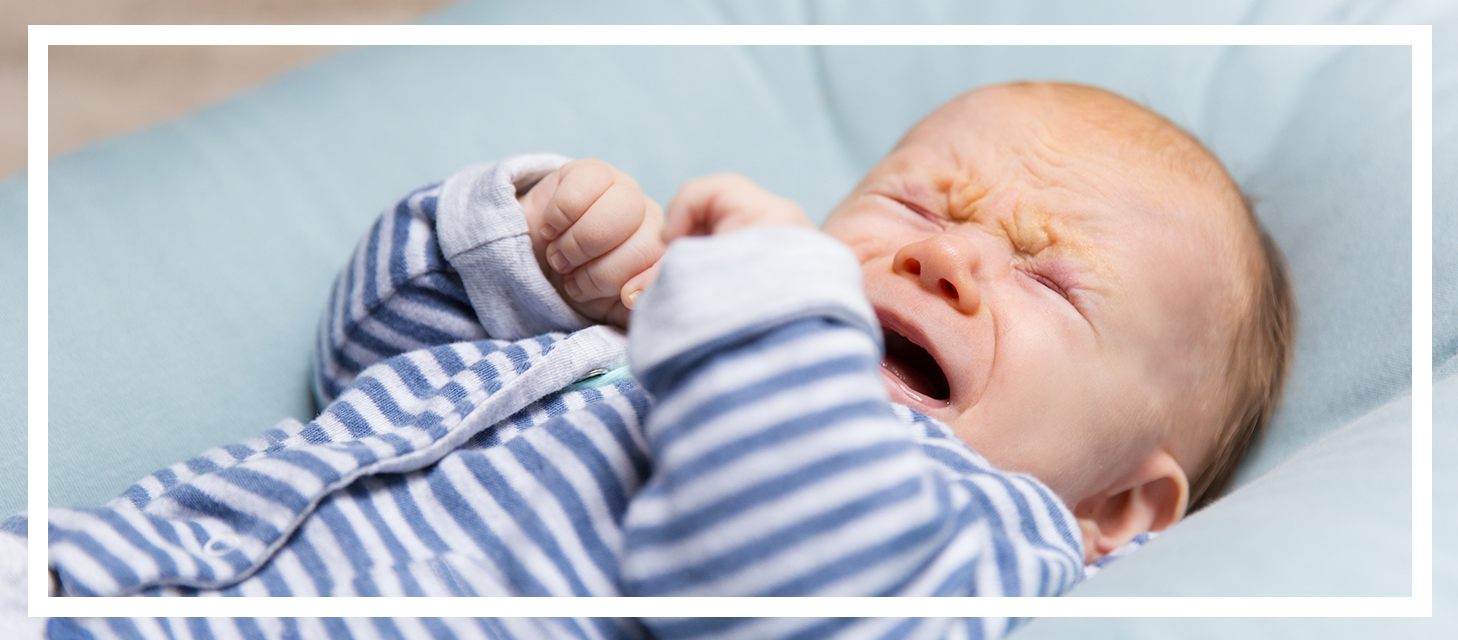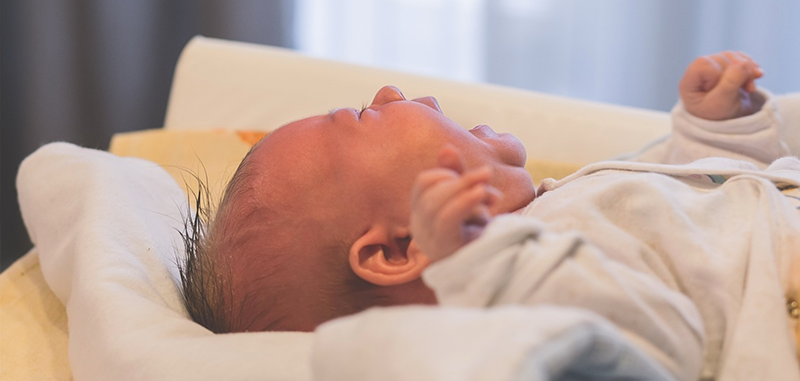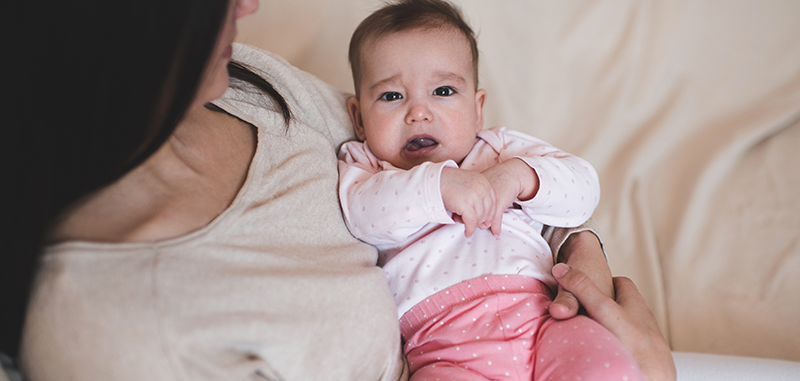Your baby cries in his sleep: what to do?

Is your baby crying at night in their sleep and you’re not sure how to respond? You’re not alone — nighttime crying is a common source of stress for many parents.
Colic, nightmares, hunger, discomfort… There are many possible reasons, but how can you identify them and, more importantly, respond in the right way?
In this article, we’ll explore the main causes of baby crying in sleep. You’ll also find practical tips to better understand your little one and help them enjoy calmer, more restful nights.
Baby Crying at Night: Physical Causes
🍼 Nighttime Feedings
One of the most common reasons for nighttime crying is, of course: hunger!
A newborn’s digestive system is still developing. Babies can’t yet store enough energy to sleep for 5 to 6 hours straight. So they wake up and cry to let you know it’s time for a feeding — breast or bottle.
- How to recognize a hunger-related wake-up: Your baby might make a specific sound — similar to Nèh¹ — clicking their tongue softly. Their eyes are open and alert, they show sucking motions, and seem fully awake. This is different from baby crying in sleep caused by normal sleep cycles, where they appear drowsy or semi-asleep.
- When does this happen? Night feedings are common until babies are able to sleep through the night. Most can go without feeding around 3 months old, though some may need a little longer.
- What should you do? Always respond to your baby’s needs. If feeding leads to a noticeable drop in nighttime crying, it’s very likely they were simply hungry!
- Important note: Don’t reduce the number of feedings too soon. Babies meet their daily nutritional needs over a wide range of feeds — anywhere from 5 to 12 per day is completely normal.
If your baby usually falls asleep — or falls back asleep — while nursing or bottle-feeding, they may now rely on those same conditions to drift off again!
This isn’t a hunger-related wake-up, but rather a sleep association your little one has developed.
Her work identified 9 distinct types of cries!
For example, hunger typically sounds like "Nèh." This cry is linked to the sucking reflex. Your baby makes a sound like "Nèh" by lightly clicking their tongue against the roof of their mouth. If you look closely at their face, you’ll notice their eyes are wide open and alert — unlike tiredness cries, where eyelids tend to droop.
💢 Colic
For babies aged 0 to 4 months, colic is a common issue — and one of the main reasons for crying at night. Up to 40% of infants are affected!
Colic is caused by a buildup of gas in your baby’s digestive system. It leads to intense discomfort and prolonged crying episodes.
- How to recognize colic: The crying is intense and low-pitched. It’s often paired with distinctive body movements: clenched fists, legs pulled up, and a flushed, red face. The pain usually starts right after a feeding. Your baby’s tummy may feel bloated, and they often pass gas. These signs don’t follow a fixed schedule — they can happen any time, day or night.
- When does it happen? Colic starts at birth and typically fades away around 3 to 4 months old.
- What can you do? Try gently massaging your baby’s tummy or use techniques to help release trapped gas. Rocking or soothing them with skin-to-skin contact can also bring comfort and help ease the crying.
- ℹ️ Tip: If you’re breastfeeding, try expressing a little milk at the beginning of a feed to reduce the intake of foremilk, which is high in sugar and can contribute to gas.
It’s a deep, guttural sound that reflects your baby’s discomfort and tummy pain!
🦷 Teething
When your baby’s first teeth start pushing through the gums, it can cause discomfort and pain — often worse at night.
- How to recognize teething: Your baby may drool more than usual, chew on anything within reach, or have red and swollen gums. The crying tends to come and go and is often accompanied by general irritability.
- When does it start? Teething typically begins between 4 and 6 months of age.
If teething is keeping your baby up or causing discomfort during the night, here are some simple and effective ways to help:
- Massage their gums: Use a clean finger or a soft, damp cloth to gently rub your baby’s gums. The soothing pressure can offer immediate relief.
- Offer a teething ring: Choose a certified, safety-approved teething ring. Chill it in the refrigerator beforehand — cool (not frozen) temperatures can help ease gum pain. Note: Never put it in the freezer, as extreme cold can be uncomfortable or even painful for your baby. Also opt for water-free designs to avoid any risk of leakage.
- Cold baby-friendly foods: If your baby is old enough (check with your pediatrician), you can offer cold foods like applesauce or yogurt. These soothing textures and temperatures can help relieve teething discomfort.
🛌 Baby Feels Uncomfortable
A full diaper, a room that's too hot or cold, or even a slight change in bedtime routine can make your baby feel unsettled.
- How to spot signs of discomfort: Start by checking your baby’s diaper. Also make sure the room temperature is between 18°C and 20°C (64–68°F). Is your baby dressed appropriately? Are the surroundings calm — not too bright or noisy? Even small changes in their bedtime routine can affect their sleep. At this age, consistency is everything.
- Monitor the room temperature: Keep it between 18°C and 20°C (64–68°F).
- Keep dust to a minimum: Air out the room daily for fresher air. Choose a firm, baby-safe mattress that provides good back support.
- Make sure your baby isn’t overheating: Use a breathable mattress cover, and avoid blankets, comforters, or loose sheets for infants. Instead, opt for a cozy sleepsuit or a soft wearable blanket (sleep sack).
- Avoid large or excessive stuffed animals: Too many plush toys can disturb your baby’s sleep during the night.
This type of cry is often paired with restless body movements.
🤢 Baby Is Sick: Unusual Crying
A fever, cold, or other illness-related discomforts can also disrupt your baby’s sleep. When babies get sick, their bodies use a lot of energy to fight off infection — and this can seriously impact their sleep!
At times like this, it’s important not to push sleep training. Focus on responding to your baby’s needs with care and comfort.
- How to tell if your baby is sick: The crying may be intense and difficult to soothe, and it’s often accompanied by other signs like fever, a runny nose, or a loss of appetite.
- What should you do? If the crying continues or you notice symptoms of illness, consult your pediatrician promptly.

Baby Is Crying... But Still Asleep
You’re fast asleep when suddenly, you hear crying… Your baby sounds upset. But when you check on them, they’re still asleep — or they settle down quickly on their own.
If this sounds familiar, you’re definitely not alone!
Many babies cry or whimper during the night without fully waking up.
So why is your baby crying in sleep — and how should you respond?
💤 What Is “Active Sleep” in Babies?
Unlike adults who fall asleep through deep (slow-wave) sleep first, babies begin their sleep cycle in what's called active sleep.
When your baby first falls asleep, you might notice small finger or toe movements, arm and leg twitches, stretches, yawns, or even soft grunts. Their face may turn red, and their eyes can move behind closed lids — sometimes even opening for a few seconds. They may even let out a quiet sob during this phase!
- How to recognize active sleep: During this stage, your baby may wiggle, whimper, or make gentle grunting sounds — sometimes with their eyes slightly open. But they’re still asleep! After a few minutes, they usually settle down and transition into a deeper, quieter sleep.
- When does it happen? Active sleep is most common between birth and 2 months of age.
- What should you do? It’s important to recognize active sleep and avoid waking your baby during this phase. As tempting as it may be to pick them up, doing so could interrupt their sleep cycle and reduce the rest they need. The best approach is to wait a little and observe. If you’re unsure whether your baby is fully awake — they’re probably still sleeping!
🚃 Micro-Wakeups & Baby Sleep Cycles
Just like adults, babies experience sleep in cycles — often referred to as “sleep trains.” During the night, your baby will go through several cycles (usually 2 or 3) before waking fully. Unfortunately, between these cycles, sleep becomes lighter — and that’s when your baby might briefly wake up!
- How to recognize them: These micro-wakeups typically occur 50 to 60 minutes after your baby first falls asleep. At this point, they might stir or even cry. And if you’re not there, or if the environment has changed since bedtime, your baby may start crying in sleep.
- What can you do? If your baby wakes up crying, ask yourself: Are the sleep conditions consistent throughout the night? Has the nightlight turned off? Did the lullaby stop playing? Some babies also fall asleep only in your arms — so if they wake up alone in their crib, they might struggle to fall back asleep on their own.
😨 Night Terrors
Night terrors are one of the most dramatic sleep disturbances — and nearly impossible to miss. Your baby may scream so loudly it echoes through the entire house. This sleep disorder is classified as a parasomnia and shares similarities with sleepwalking.
- How to recognize them: Night terrors involve intense crying, screaming, or yelling — often with no awareness of the surroundings. Your child’s heart rate and breathing speed up, they may thrash around or sweat heavily. And then, just a few minutes later, they settle back into sleep. By morning, they remember nothing of the episode.
- When do they happen? Don’t panic! Although scary to witness, these episodes are fairly common in children aged 18 months to 4 years.
- Up to 40% of children will experience at least one episode of “night terrors.” They most often occur early in the night (between 8:00 p.m. and 11:00 p.m.).
- What should you do? Believe it or not, your baby is still asleep during a night terror. As difficult as it may be, the best thing to do is… nothing. Wait it out — your child won’t recognize you in that moment and trying to wake them may make things worse.
Want to learn more about night terrors? Check out our full article: 📁 Night Terrors: What to Do When Your Baby Screams in the Night?
Other (Less Common) Causes
Baby crying in sleep can sometimes be triggered by less obvious causes.
In fact, many different factors can disrupt an infant’s sleep, leading to unexpected nighttime crying.
These periods often align with major developmental milestones, such as learning to walk or talk, and commonly occur around 4, 8, or 12 months.
Crying during a regression is very common, as your baby may be more restless and have trouble transitioning between sleep cycles. During this time, it’s important to be patient and keep a consistent routine to help them through it.
Want to learn more about sleep regressions? Check out our guide: 📁 Baby Sleep Regressions | From 4 Months to 2 Years
Crying helps your baby flush out stress hormones such as cortisol that build up during the day. When disruptive events occur, cortisol levels rise, making it harder to fall asleep. If those levels remain high in the evening, they can block the release of melatonin—the sleep hormone. By crying, your baby relaxes and becomes ready for sleep, which is different from baby crying in sleep that happens during the night’s lighter phases.
To learn more about discharge cries, read our detailed article: 📁 Discharge Cries in Babies: Understanding and Supporting Them
Here are a few tips to help your baby become more independent with their pacifier:
- During the day, offer the pacifier and let your baby try picking it up by themselves. At first, it might end up anywhere but their mouth! But over time, they’ll begin to understand how it works.
- Place several pacifiers in the crib so they can easily find one if they wake during the night.
- Some pacifiers are glow-in-the-dark, which can help your baby spot one more easily in the dark.
- If your baby is still very young, you can place the pacifier in their hand and gently guide it to their mouth. This helps them learn the steps and what’s expected of them at night.

How to Respond When Your Baby Cries in Their Sleep
1. Observe Before Intervening
Before rushing in, take a few seconds to observe your baby.
Especially if the crying happens just after they've fallen asleep, your little one may simply be between two sleep cycles or in an active sleep phase.
If the crying is brief and low in intensity — even if their eyes are open — chances are your baby will fall back asleep on their own. Picking them up right away may actually wake them fully and disrupt the rest of their night.
2. Recognize the Signs of a Real Need
If your baby keeps crying or seems inconsolable, it’s time to check for and respond to their basic needs.
Thanks to the research of Priscilla Dunstan, here are some cues that may help you understand what your baby is trying to communicate:
This Australian researcher identified several different "types of cries" babies use to express specific needs:
Hunger ("Nèh")
This cry is linked to the sucking reflex. Your baby makes a "nèh" sound by lightly clicking their tongue against the roof of their mouth. Their eyes are wide open and alert — unlike sleep cries, where the eyelids are heavy.Sleepiness ("Aeh")
When your baby needs sleep, they may let out a mewing sound, "aeh", often accompanied by a yawn. Their mouth forms a small "o", their eyes are half-closed, and their gaze seems far away — a clear sign they’re ready to drift off.Burp ("Eh")
A trapped burp causes a short, "eh"-like sound, often with squirming or stretching movements. This cry typically happens after feeding. Helping your baby burp often brings quick relief.Discomfort ("Hèh")
If your baby is too hot, too cold, or has a full diaper, they may produce a panting sound, "hèh", along with restless movements.Colic ("Eerrrrhhh")
Colic-related cries are intense and guttural. Your baby may make a deep, drawn-out "eerrrrhhh" sound, with clenched fists, tensed legs, and visible signs of distress.
3. Create a Sleep Routine
From the very first month, establishing a bedtime routine is key.
At this age, your baby’s internal clock is still developing.
A soothing bedtime routine provides clear signals that it’s time to wind down. Repeating calming steps every evening helps your baby associate them with sleep, making it easier to fall asleep — and hopefully stay asleep longer, benefiting the whole family.
Creating this routine early lays a strong foundation to prevent sleep disturbances later on. The earlier it’s introduced, the more comforting and familiar it becomes. Trust us — this is a gift for everyone in the household!
Over time, the effects of the routine only grow stronger. As your baby matures, they’ll begin to anticipate and mentally prepare for bedtime, which makes falling asleep much easier. And the best part? It teaches your child healthy sleep habits from the very beginning — a lifelong benefit.
To learn more about creating a great bedtime routine, check out our article: Bedtime Routine for Babies: Tips for a Peaceful Night
4. Identify a Medical Issue
If the crying becomes frequent, high-pitched, or is accompanied by unusual symptoms, consult your pediatrician. Medical issues like reflux (GERD), ear infections, or food allergies can lead to persistent nighttime crying.
5. Mistakes to Avoid
- Waking your baby every time: During active sleep phases, crying usually doesn’t require intervention. Waking them can interfere with their natural sleep cycles.
- Overstimulating too quickly: Avoid bright lights or loud sounds. Stick to soft lighting and a calm environment if you need to check on your baby.
- Ignoring signs of overtiredness: Crying at night may be a sign that your baby is overly tired. Look for signs like yawning, rubbing eyes, or a blank stare.
- Overlooking recurring issues: If crying continues night after night, it could indicate an underlying problem that needs medical attention.
Skin-to-skin contact is an especially effective way to soothe nighttime crying, once you’ve made sure all their basic needs are met (hunger, diaper, temperature, etc.).
Should You Let Your Baby Cry in Their Sleep? NO!
The question of whether you should let your baby cry at night often sparks strong debate. While some approaches suggest this method helps a baby become more independent, it’s important to understand the deeper meaning behind those tears.
For an infant, crying is never just a whim — it’s an instinctive way to express a fundamental need, whether for comfort, security, or attention. As completely dependent beings, babies rely on their parents to meet both their physical and emotional needs.
What Happens When You Let a Baby Cry?
If you choose not to respond right away, it’s true that your baby may eventually fall asleep. But this is often due to sheer exhaustion and elevated stress levels — not genuine calm or self-soothing.
“Cry it out” methods may help reduce the number of night wakings — as shown in one study¹ — but they don’t address the underlying causes of the crying.
Silence doesn’t mean a lack of stress. It may mean your baby has simply stopped expressing their emotions, which can have negative effects on emotional development.
¹: "Behavioral treatment of bedtime problems and night wakings in infants and young children" (Mindell, Jodi A., Kuhn, Brett, Lewin, Daniel S., Meltzer, Lisa J. - 2006)
The Impact on Attachment
Repeatedly letting a baby cry for extended periods may undermine the attachment bond between parent and child. It can teach your baby that their needs won’t be met, which may weaken their sense of safety and trust in caregivers.
That said, it doesn’t mean you need to respond to every whimper. Sometimes, taking a brief pause allows parents to manage their own emotions and respond more calmly and appropriately to their baby’s needs.
Finding Balance
You don’t need to reject the idea entirely, but it should be used sparingly and with great care. Responding to cries thoughtfully — without letting your baby reach a point of total exhaustion — strengthens attachment and supports healthy emotional development for the whole family.
If you’re unsure, trust your instincts and choose a response that prioritizes your child’s well-being and sense of security. For a deeper look at this topic, read our full article: 📁 Letting Your Baby Cry: Effective, But at What Cost?
The main causes of nighttime crying in babies aged 0 to 4 months are, in order of frequency:
- Hunger (baby needs a feed)
- Colic (baby has tummy pain)
- Discomfort (wet diaper, room too hot or cold, etc.)
- Teething (baby’s first teeth are coming in)
- Active sleep phase (cries are short and baby falls back asleep)
- Night terror (cries are intense but baby returns to sleep without waking fully)
Discover REMI
THE SMART BABY MONITOR 😊
REMI and its app bring together everything you need to manage your baby’s sleep!
Its mission? Helping families sleep better — from birth up to age 10.
I bought REMI for my 4-year-old son who didn’t want to sleep alone anymore after his little sister was born. Thanks to the remote wake-up system and bedtime stories I can play from a distance, the issue is completely resolved! I 100% recommend this purchase!






 White noise for baby : a scientific research !
White noise for baby : a scientific research !
 What are the positive effects of napping on memory?
What are the positive effects of napping on memory?
 When do babies sleep through the night ? Tips and tricks !
When do babies sleep through the night ? Tips and tricks !
 Night terrors in babies: don't panic!
Night terrors in babies: don't panic!
 1 Month Old Baby Sleep : Common Questions
1 Month Old Baby Sleep : Common Questions